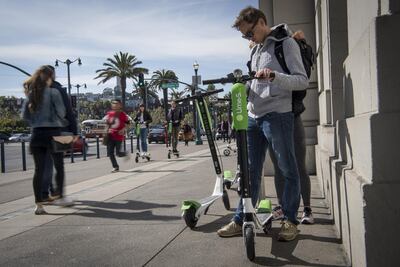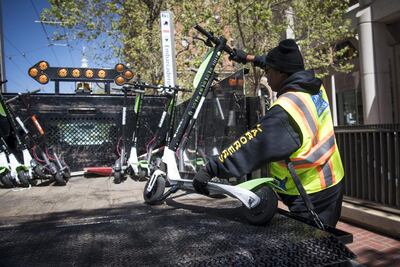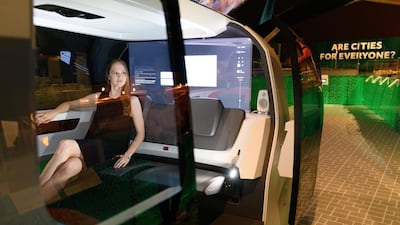Over the past several months a handful of start-ups have dropped hundreds or thousands of electric scooters on the sidewalks in cities like San Francisco, Austin, and San Diego, allowing anyone who downloads an app to unlock and ride them across town for a small fee.
It’s a radical – and controversial – experiment in urban mobility. But scooters could be just the beginning.

Lime, a company that runs sharing services for scooters, pedal bikes and e-bikes, is developing a new type of vehicle known internally as a “transit pod”. The concept is in early stages and the design is still in flux. But Lime’s plan is to build an enclosed, electric vehicle that could hold one or two people, resembling a smart car or a deluxe golf cart. The vehicle wouldn’t be a car, exactly; it’s not even clear whether it would have three or four wheels, according to Bloomberg. But it would drive in normal street traffic, and could hit a top speed of about 70kph, said Brad Bao, Lime’s co-founder and chairman.
The company is not alone in looking to develop driverless pod transport systems. In March Volkswagen confirmed at its annual media conference that it’s going to bring one of its most eccentric concepts to production – the all-electric Sedric shuttle, which is more tiny pod bus than car, will eventually actually get made, after its design is refined by one of the Volkswagen Group’s portfolio brands through a further development process.
"Our team is already working on ideas for an entire Sedric family. This will range from fully autonomous vehicles for the city, through luxurious long-distance mobility and spectacular sports cars, self-driving delivery vans and heavy trucks," the company had announced in September last year.

"SedricE is a synonym for the future of individual mobility," said Johann Jungwirth, chief digital officer of the Volkswagen Group.
"The initial self-driving vehicles will be seen on the streets of the first cities from 2021. There will be an exponential development taking place across a large number of regions."
Back in the US, unlike Lime’s scooters, which tend to end up littering the sidewalks and exasperating the non-scooting public, unused pods would be parked in street parking spots.

Mr Bao predicts two or three of them would fit into a single spot. Customers would access the pods through a sharing service available in the company’s app, seeing them as another transport option alongside scooters and electric and pedal bicycles.
Of course, the idea of autonomous pods is nothing new in the UAE. In February The National reported that Sheikh Mohammed bin Rashid, Vice President and Ruler of Dubai, attended initial tests of the world's first autonomous pods.
The project has been developed by the Roads and Transport Authority in co-operation with Next Future Transportation.
The initial tests took place on the sidelines of the World Government Summit in Dubai and was attended by Sheikh Hamdan bin Mohammed, Crown Prince of Dubai, Sheikh Mansour bin Mohammed, and Mohammad Al Gergawi, Minister of Cabinet Affairs and the Future.

The autonomous pods are designed to travel short and medium distances in dedicated lanes. They can be coupled or detached, depending on the destination of riders, within seconds. They are fitted with cameras and electromechanical technologies to perform the coupling and detaching processes, which can be activated while in motion, reported state news agency Wam.
Each pod measures almost 3m in length, and stands 2.8m high. They weigh in at 1,500kg and they have the capacity to accommodate ten riders – six seated and four standing. The autonomous pod is fitted with a battery that supports three hours of operation, and can be fully charged in six hours. Its average speed is 20kph.
“The pilot test of driverless units is directed by Sheikh Mohammed bin Rashid, in the context of transforming Dubai into the smartest city worldwide," said Mattar Al Tayer, director-general and chairman of the RTA executive directors board.
“It echoes the Dubai Autonomous Transport Strategy aimed at converting 25 per cent of mobility journeys in Dubai to autonomous transportation by 2030."
The RTA has signed an agreement with American Next Future Inc to develop autonomous units named NX1 as part of the initial phase of Dubai Future Accelerators. The prototypes of these units are being manufactured in Italy and shipped to Dubai for trials, Mr Al Tayer said.
The autonomous pods have three protection systems in order to ensure full control and avoid accidents.
Cities need pods because traditional cars are overkill for the bulk of urban driving, Mr Bao told Bloomberg. Most trips consist of a single person looking to travel three miles or less. “They don’t need to have a five seater or a seven-seater, plus all that gasoline consumption,” he said. "But there is no such product out there to meet their needs.” he said. “Our goal is to be a leading multi-modal company,” said Toby Sun, co-founder and chief executive.
_______________
Read more:
World Government Summit: $5m prize for best autonomous vehicle concept
Davos 2018: Transport revolution will come earlier in countries such as the UAE
_______________
Lime isn’t the first company with a utopian plan for tiny, car-like vehicles that run on electricity. In the early 2000s, Ford made a line of similar vehicles it called TH!NK. It discontinued them, and a company that subsequently attempted to build them as an independent venture failed. Used models still float around Craigslist for a few thousand dollars. Arcimoto, a small, publicly traded company based in Eugene, Oregon, has been working on two-seat, three-wheeled electric vehicles for a decade, and began delivering its first shipments to customers last fall. Electra Meccanica, a Canadian startup that makes three-wheelers that look like regular cars with the back half cut off, said recently it has begun delivering them to the United States.
For the last year, Lime has attempted to differentiate itself from other scooter and bike sharing companies like Bird, Spin, and Jump by offering a wider range of vehicles, and by playing a more active role in the manufacturing process. It has operations in China that oversee the building of scooters and bicycles. Making pods would be a significantly larger design and manufacturing challenge. The company is still in the testing phase and would need to find manufacturing partners. The timeline of the project and the number of pods Lime would try to produce is unclear.
One key design feature could be how many wheels the pods have, because that will impact the regulatory landscape. The federal government has regulated low-speed motor vehicles since 1998, when it passed rules to allow people to drive their golf carts to run errands, so long as the vehicles met certain requirements. The rules relate to four-wheeled vehicles weighing less than 3,000 pounds whose top speed is 20 to 25 miles per hour. At the time, regulators were primarily concerned with retirement communities and other controlled environments - not downtown San Francisco. Three-wheeled vehicles are regulated as motorcycles.
Most states have also passed regulations for low-speed motor vehicles, generally limiting their use to roads with lower speed limits. Some cities also have their own regulations. In Austin, for instance, low-speed vehicles can’t go faster than 35kph, must carry insurance, can’t carry more than six people, and have to be clearly marked. The city code also includes a series of standards for low-power electric vehicles that serve as cabs. Some state laws would let cities ban low-speed motor vehicles altogether.
Mr Bao said Lime would also pursue deals for the pods to be parked in on-street parking spots, akin to the car-sharing company Car2Go. This would allow someone to pick up a pod, drive it across town, and leave it at his or her destination. Programmes to offer car-sharing companies city contracts for such arrangements are emerging; San Francisco approved its programme last year, citing research that each shared car could result in seven to 15 privately-owned vehicles being removed from the streets. The city’s transportation department said it hadn’t received any requests for shared parking from companies utilising such novel vehicles.
Sven Beiker, managing director of Silicon Valley Mobility, a transportation consultancy, predicts the economics will be tricky. “It seems you’re getting into a challenging business with car sharing, and a challenging business with low-volume manufacturing,” he said.
As with many forms of alternative transport, a major difficulty is how they’d fit into a landscape dominated by traditional cars. People driving underpowered pods through streets filled with 4x4s could feel uneasy. The best chance for pods, said Mr Beiker, would be more aggressive actions to ban full-sized cars from central cities. “We have to say, ‘no, don’t bring your pickup truck downtown,’” he said.

